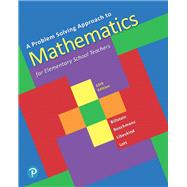NOTE: Before purchasing, check with your instructor to ensure you select the correct ISBN. Several versions of the MyLab™ and Mastering™ platforms exist for each title, and registrations are not transferable. To register for and use MyLab or Mastering, you may also need a Course ID, which your instructor will provide.
Used books, rentals, and purchases made outside of Pearson
If purchasing or renting from companies other than Pearson, the access codes for the MyLab platform may not be included, may be incorrect, or may be previously redeemed. Check with the seller before completing your purchase.
For courses in Math for Future Elementary Teachers.
This package includes MyLab Math.
A concept-rich, skill-based approach to preparing outstanding elementary math teachers
A Problem Solving Approach to Mathematics for Elementary School Teachers not only helps students learn the math — it provides an invaluable reference to future teachers by including professional development features and discussions of today’s standards.
Revised throughout to prepare students more effectively for their own classrooms, the 13th Edition gives instructors a variety of approaches to teaching, and encourages discussion and collaboration among students and with their instructors. The MyLab™ Math course for this revision is updated extensively with new resources and features.
The Common Core Standards are used in the text to highlight concepts. The National Council of Teachers of Mathematics (NCTM) publications, Principles and Standards of School Mathematics (2000) and Principles to Actions: Ensuring Mathematical Success for All (2014) are reflected throughout.
Personalize learning with MyLab Math
By combining trusted author content with digital tools and a flexible platform, MyLab Math personalizes the learning experience and improves results for each student.
0135261686 / 9780135261682 A Problem Solving Approach to Mathematics for Elementary School Teachers - Access Card Package, 13/e
Package consists of:
- 013518388X / 9780135183885 A Problem Solving Approach to Mathematics for Elementary School Teachers
- 0135190053 / 9780135190050 MyLab Math with Pearson eText - Standalone Access Card - for A Problem Solving Approach to Mathematics for Elementary School Teachers












